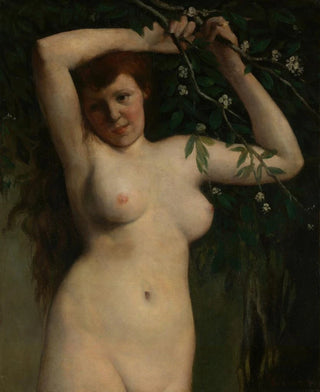Art print | Nude with flowering branch - Gustave Courbet


View from behind

Frame (optional)
In the vibrant universe of art, some works stand out for their ability to capture the very essence of beauty and truth. "Nu à la branche fleurie," an iconic art print by Gustave Courbet, embodies this quest for authenticity that characterizes the realist movement. Through this bold representation of a nude woman, the artist does not merely depict a body; he invites the viewer to a profound reflection on the nature of sensuality and the relationship between man and nature. This painting, both provocative and delicate, bears witness to a time of great change, where art emancipates itself from academic conventions to embrace a more personal and introspective vision.
Style and uniqueness of the work
Courbet's style in "Nu à la branche fleurie" is a celebration of material and light. The artist uses rich colors and striking contrasts to bring his subject to life. The woman's skin, with a disturbing realism, seems to almost vibrate under the brushstrokes, while the delicately placed flowering branch adds a touch of poetry to the composition. This fusion between the human body and nature is a key characteristic of the work, highlighting the harmony between human beings and their environment. Courbet, by avoiding classical idealizations, chooses to depict nudity in a raw and authentic manner, provoking an intense emotional reaction in the viewer. This bold stylistic choice makes "Nu à la branche fleurie" a singular work that continues to fascinate and provoke reflection.
The artist and his influence
Gustave Courbet, an emblematic figure of realism, revolutionized the art world in the 19th century. Born in 1819, he dedicated his life to challenging established norms, preferring to depict life as it is, with its imperfections and beauties. His innovative approach paved the way for many artists, influencing movements such as Impressionism and Symbolism. Courbet did not limit himself to painting historical or mythological scenes; he was interested in everyday life, nature, and the human condition.

Matte finish

View from behind

Frame (optional)
In the vibrant universe of art, some works stand out for their ability to capture the very essence of beauty and truth. "Nu à la branche fleurie," an iconic art print by Gustave Courbet, embodies this quest for authenticity that characterizes the realist movement. Through this bold representation of a nude woman, the artist does not merely depict a body; he invites the viewer to a profound reflection on the nature of sensuality and the relationship between man and nature. This painting, both provocative and delicate, bears witness to a time of great change, where art emancipates itself from academic conventions to embrace a more personal and introspective vision.
Style and uniqueness of the work
Courbet's style in "Nu à la branche fleurie" is a celebration of material and light. The artist uses rich colors and striking contrasts to bring his subject to life. The woman's skin, with a disturbing realism, seems to almost vibrate under the brushstrokes, while the delicately placed flowering branch adds a touch of poetry to the composition. This fusion between the human body and nature is a key characteristic of the work, highlighting the harmony between human beings and their environment. Courbet, by avoiding classical idealizations, chooses to depict nudity in a raw and authentic manner, provoking an intense emotional reaction in the viewer. This bold stylistic choice makes "Nu à la branche fleurie" a singular work that continues to fascinate and provoke reflection.
The artist and his influence
Gustave Courbet, an emblematic figure of realism, revolutionized the art world in the 19th century. Born in 1819, he dedicated his life to challenging established norms, preferring to depict life as it is, with its imperfections and beauties. His innovative approach paved the way for many artists, influencing movements such as Impressionism and Symbolism. Courbet did not limit himself to painting historical or mythological scenes; he was interested in everyday life, nature, and the human condition.






